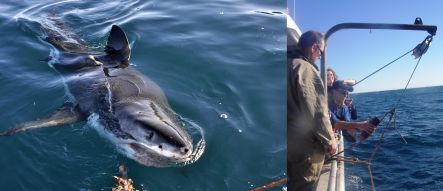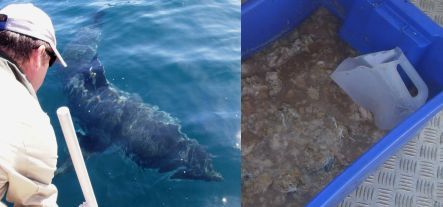
Tagged shark Marbletail lunges at a tuna bait being dragged through the water to attract him close enough to the boat to be tagged, and Clinton Duffy and Malcolm Francis attach an acoustic receiver to a mooring buoy (images: M. Francis and A. Ballance)
For the last six years a joint NIWA-Department of Conservation research team has been tagging and photographing great white sharks in Foveaux Strait, in an effort to learn how many of these enigmatic predators live there and how they spend their year. Satellite tagging has shown that each winter the sharks migrate to the tropics, returning in summer to ‘hang out’ near seal colonies around Stewart Island. Acoustic tags are now revealing more about how sharks move around the local area, and Alison Ballance joins shark experts Malcolm Francis from NIWA and Clinton Duffy from DoC on their annual tagging trip as they lure great white sharks alongside the boat and attempt to attach acoustic and satellite tags. They take photographs to individually identify sharks from their colours and patterns, and they soon meet new sharks such as the strikingly-marked Scar Face, along with old familiars such as Horse and Marbletail. During the course of this year’s two-week long expedition the team attached 20 acoustic tags and 5 pop-off archival (PAT) satellite tags. They report they are still carrying out the photo identification work, but that they saw many known sharks and about the same number of new sharks, that the greatest number of sharks they saw on one day was 13, and that two large females – Miranda and Ella – who have been a feature of previous tagging trips were conspicuously absent, leading to speculation that perhaps they have matured and are away breeding (very little is known about great white shark breeding). Malcolm Francis and Clinton Duffy have previously featured on Our Changing World talking about their shark research. Click here to listen to Malcolm talking about sharks in general, click this link for an interview about shark finning, click here for a story surveying rig nursery grounds in estuaries, and click here to listen to Clinton and Malcolm talk about the long-distance migrations that New Zealand sharks make to the tropics.

Clinton Duffy uses an underwater camera on a pole to photo identify a great white shark (this one has a tag floating by its dorsal fin), and the oily tuna berley poured into the water to attract sharks to the boat (images: A. Ballance)

